My New IrrigationController
-
@epierre
Started to play with LM2596, I've got sth. like this:
http://www.ebay.com/itm/1pcs-1-23V-30V-DC-DC-Buck-Converter-Step-Down-Module-LM2596-Power-Supply-Output-/400985220074?hash=item5d5c94e3ea:g:o10AAOxy0x1TVSpDAdded diode bridge between transformer and this converter. But my concern is that I've some big voltage peaks the the output of it. It happens when I'm opening/closing valves (AC solenoids) connected to this transformer.
Set this converter to 12V DC but my readings are sometimes around 20V DC and I am affraid that I could destroy by Arduino.
Do you (anyone) have any suggestion ? -
Just wondering, could you not set your zones up as an array. This would reduce the size a little and should also free up memory for variables.
@gbgent_nc
Yes I could and did already because have to use ProMini [my MEGA2560 was killed ;) ].
Anyway plan is now to use 2xProMini., one for LCD, Keyboard, relays and second for temperature x2, water meter, rain sensor and relay for pump. -
@fets
Manufacturer is RAIN S.p.a Italy, www.rain.it.
Model I use is RN150.
Got them from Leroy Merlin, price was around 11 EUR. -
Last summer during vacation, was quite hot at my place. My green grass in the garden became ... brown and yellow - there was nobody to irrigate and was no rain, of course!
So I made a decision to buy irrigation controller and all that stuff. I wanted to have 7-8 zones, BT or wireless control, temperature and rain based control, RTC, Keypad, etc. The problem was that nobody had it or was to expencive.
So long story short I came up with idea to build one with all those features i need. Without having experience with uC I start to learn (google and youtube) a bit and build some "prototypes". Than IrrigatonController ver 1.0 was ready (December 2015):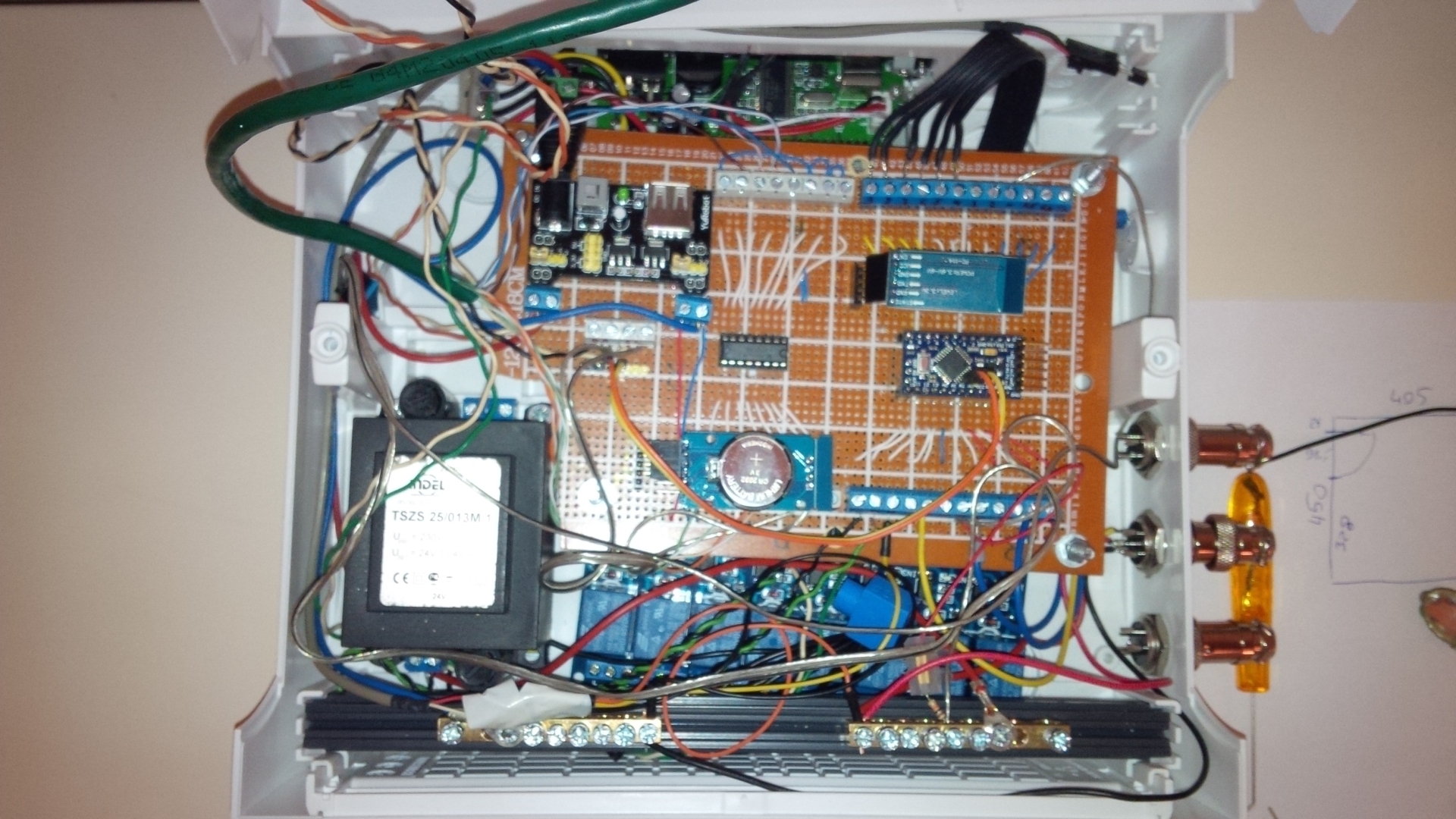
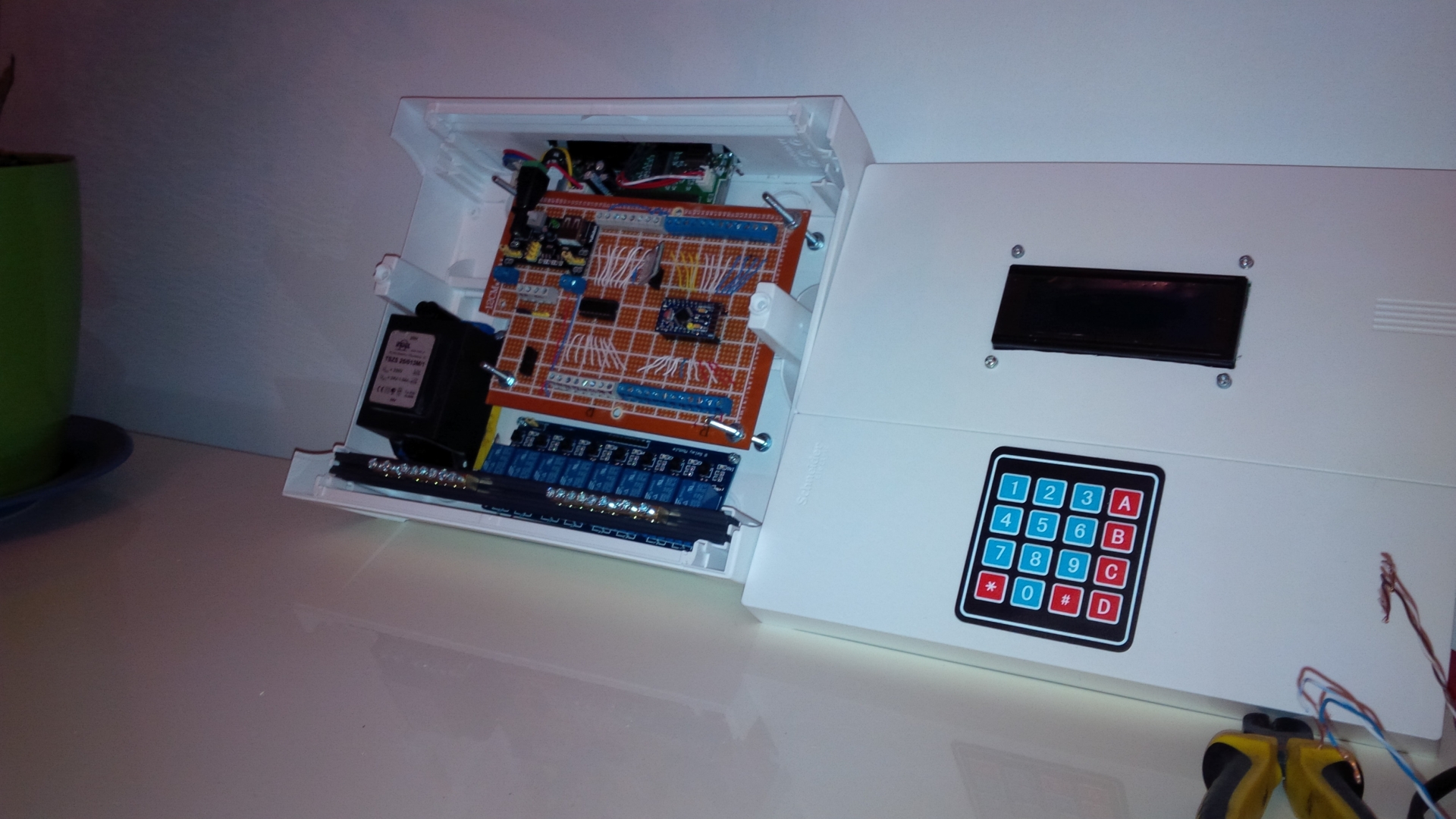
Than I found @petewill IrrigationControler at youtube - but it was to hard for me from software (all this MySensors) and hardware side - I thought!
So I built new one - well it is almost done.
It is tested and working, few things are still missing like running without HA controller and rain sensor. Anyway I post some pictures and script what I've done. At my place it is working under Domoticz and manual (keypad). Tomorrow final wiring!
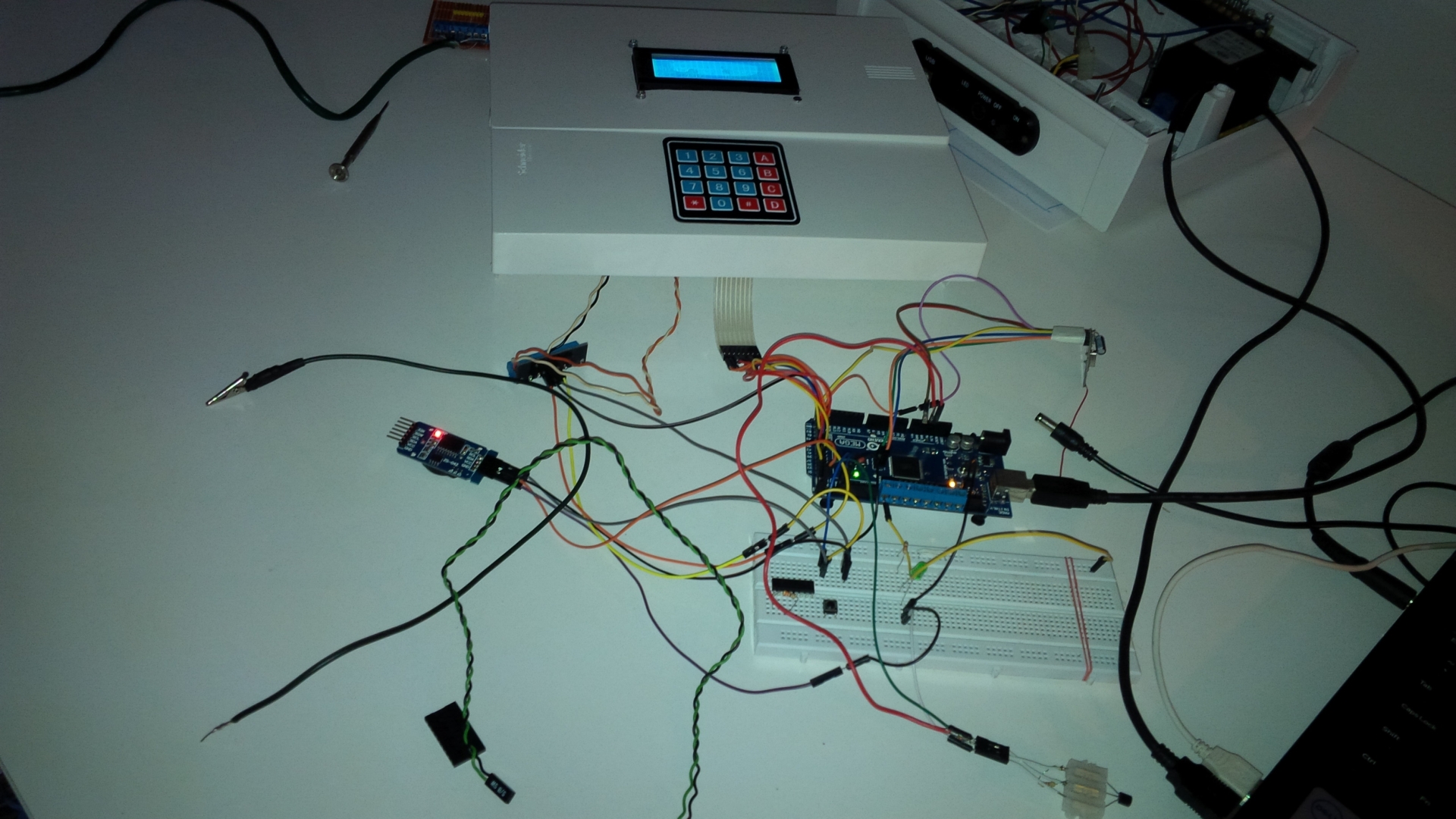
 .
.Any comments are more than welcome, know that script need some more work - but it is just a beginning.
/** * The MySensors Arduino library handles the wireless radio link and protocol * between your home built sensors/actuators and HA controller of choice. * The sensors forms a self healing radio network with optional repeaters. Each * repeater and gateway builds a routing tables in EEPROM which keeps track of the * network topology allowing messages to be routed to nodes. * * Created by Henrik Ekblad <henrik.ekblad@mysensors.org> * Copyright (C) 2013-2015 Sensnology AB * Full contributor list: https://github.com/mysensors/Arduino/graphs/contributors * * Documentation: http://www.mysensors.org * Support Forum: http://forum.mysensors.org * * This program is free software; you can redistribute it and/or * modify it under the terms of the GNU General Public License * version 2 as published by the Free Software Foundation. * ******************************* * * REVISION HISTORY * based on Version 1.0 - Henrik Ekblad * Version 2.0 - Marek Dajnowicz * * DESCRIPTION * Example sketch showing how to control physical relays. * * http://www.mysensors.org/build/relay */ // Enable debug prints to serial monitor #define MY_DEBUG #define MY_RF24_CE_PIN A8 // żółty 51 #define MY_RF24_CS_PIN A9 // pomarańczowy 53 // Enable and select radio type attached #define MY_RADIO_NRF24 //#define MY_RADIO_RFM69 #define MY_NODE_ID 66 // Enable repeater functionality for this node #define MY_REPEATER_FEATURE #include <Wire.h> #include <Time.h> #include <SPI.h> #include <MySensor.h> #include <LiquidCrystal.h> #include <LiquidCrystal_I2C.h> #include <DallasTemperature.h> #include <OneWire.h> #include <DS3232RTC.h> // A DS3231/DS3232 library #include <Keypad_I2C.h> // Klawiatura na I2c #include <Keypad.h> // klawiatura #define RELAY_1 2 // Arduino Digital I/O pin number for first relay (second on pin+1 etc) #define NUMBER_OF_RELAYS 8 // Total number of attached relays #define RELAY_ON 1 // GPIO value to write to turn on attached relay #define RELAY_OFF 0 // GPIO value to write to turn off attached relay #define ONE_WIRE_BUS 22 // Pin where dallase sensor is connected MEGA256 #define MAX_ATTACHED_DS18B20 16 #define TEMPERATURE_PRECISION 12 #define CHILD_ID_SPRINKLER1 1 #define CHILD_ID_SPRINKLER2 2 #define CHILD_ID_SPRINKLER3 3 #define CHILD_ID_SPRINKLER4 4 #define CHILD_ID_SPRINKLER5 5 #define CHILD_ID_SPRINKLER6 6 #define CHILD_ID_SPRINKLER7 7 #define CHILD_ID_PUMP 10 #define CHILD_ID_TEMP 11 #define CHILD_ID_TEMP2 12 OneWire oneWire(ONE_WIRE_BUS); // Setup a oneWire instance to communicate with any OneWire devices (not just Maxim/Dallas temperature ICs) DallasTemperature sensors(&oneWire); // Pass the oneWire reference to Dallas Temperature. boolean timeReceived = false; byte clock[8] = {0x0, 0xe, 0x15, 0x17, 0x11, 0xe, 0x0}; // fetching time indicator byte raindrop[8] = {0x4, 0x4, 0xA, 0xA, 0x11, 0xE, 0x0,}; // fetching Valve Data indicator LiquidCrystal_I2C lcd(0x27, 2, 1, 0, 4, 5, 6, 7, 3, POSITIVE); // Set the LCD I2C address to 0x27 DeviceAddress addrT1 = { 0x28, 0xFF, 0x9F, 0x80, 0x93, 0x15, 0x04, 0xF7 }; //DS18 Dallas temp. float T1; float lastTemperature[MAX_ATTACHED_DS18B20]; int numSensors = 0; MyMessage msgValve1(CHILD_ID_SPRINKLER1, V_LIGHT); MyMessage msgValve2(CHILD_ID_SPRINKLER2, V_LIGHT); MyMessage msgValve3(CHILD_ID_SPRINKLER3, V_LIGHT); MyMessage msgValve4(CHILD_ID_SPRINKLER4, V_LIGHT); MyMessage msgValve5(CHILD_ID_SPRINKLER5, V_LIGHT); MyMessage msgValve6(CHILD_ID_SPRINKLER6, V_LIGHT); MyMessage msgValve7(CHILD_ID_SPRINKLER7, V_LIGHT); MyMessage msgPump(CHILD_ID_PUMP, V_LIGHT); MyMessage msgT1(CHILD_ID_TEMP, V_TEMP); MyMessage msgT2(CHILD_ID_TEMP2, V_TEMP); /**** Kepad settings */ const byte ROWS = 4; const byte COLS = 4; char keys[ROWS][COLS] = { {'1', '2', '3', 'A'}, {'4', '5', '6', 'B'}, {'7', '8', '9', 'C'}, {'*', '0', '#', 'D'} }; byte rowPins[ROWS] = {47, 45, 43, 41}; byte colPins[COLS] = {39, 37, 35, 33}; int i2caddress = 0x20; Keypad_I2C kpd = Keypad_I2C( makeKeymap(keys), rowPins, colPins, ROWS, COLS, i2caddress ); bool state; // system messages const char *string_table[] = { " WELCOME! =)", // 0 "DOMOTICZ TIME", // 1 "WATERING", // 2 " SYSTEM CHECK ", // 3 " STARTING UP THE", // 4 " WATERING SYSTEM", // 5 " Popmp is ON ", // 6 " MySensors", // 7 " Watering System", // 8 " Please wait !!" // 9 }; const char *string_table2[] = { "Strefa 1", "Strefa 2", "Strefa 3", "Strefa 4", "Strefa 5", "Strefa 6", "Strefa 7", "Pompa zasilająca" // ZONE 1...2... }; const unsigned long tUpdate = 60000; // update interval for temp sensors unsigned long t0; void setup() { for (int sensor = 1, pin = RELAY_1; sensor <= NUMBER_OF_RELAYS; sensor++, pin++) { pinMode(pin, OUTPUT); // Then set relay pins in output mode digitalWrite(pin, RELAY_OFF); // set all relays OFF saveState(sensor, state); // save data at startup. } requestTime(); kpd.begin(); //keypad sensors.begin(); //dallas temp sensors.setResolution(addrT1, TEMPERATURE_PRECISION); lcd.begin(20, 4); //(20 characters and 4 line display) lcd.clear(); lcd.backlight(); lcd.createChar(0, clock); lcd.createChar(1, raindrop); lcd.home(); lcd.print(string_table[4]); lcd.setCursor(0, 1); lcd.print(string_table[5]); lcd.setCursor(0, 3); lcd.print(string_table[7]); delay(3000); for (int i = 0; i < 20; i++) { delay(100); lcd.scrollDisplayLeft(); } lcd.clear(); lcd.home(); lcd.print(string_table[0]); lcd.setCursor(0, 1); lcd.print(string_table[3]); (lcd.setCursor(0, 3)); for (int M = 1; M >= 0; M--) // countdown { lcd.setCursor(10, 3); lcd.print(M); delay(1000); } lcd.clear(); lcd.home (); requestTime(); ServerUpdate(); } void presentation() { // Send the sketch version information to the gateway and Controller sendSketchInfo("Watering", "2.0"); for (int sensor = 1, pin = RELAY_1; sensor <= NUMBER_OF_RELAYS; sensor++, pin++) { // Register all sensors to gw (they will be created as child devices) present(sensor, S_LIGHT, string_table2[sensor - 1]); // use CHILD ID names from table } present(CHILD_ID_TEMP, S_TEMP,"Dallas"); present(CHILD_ID_TEMP2, S_TEMP,"RTC Temp"); } void loop() { domoticztime(); // to PRINT the time from conroller keypad(); // READING KEYPAD if ((millis() - t0) > tUpdate) ServerUpdate(); } void ServerUpdate() { sensors.requestTemperatures(); T1 = sensors.getTempC(addrT1); send(msgT1.set(T1 , 1)); int t= RTC.temperature()/4; send(msgT2.set(t,2)); lcd.setCursor(11, 2); lcd.print("T:"); lcd.print(T1); lcd.print(char(223)); lcd.print("C"); lcd.setCursor(11, 3); lcd.print("T:"); lcd.print(t); lcd.print(char(223)); lcd.print("C"); t0 = millis(); } void domoticztime() { lcd.home(); lcd.setCursor(0, 2); // lcd.print(string_table[1]); //lcd.setCursor(2, 2); lcd.write(byte(0)); lcd.setCursor(1, 2); lcd.print(hour()); lcd.print(":"); int min = minute(); if (min < 10) lcd.print("0"); lcd.print(minute()); lcd.print(":"); lcd.print(second()); lcd.setCursor(0, 3); lcd.print(day()); lcd.print("/"); lcd.print(month()); lcd.print("/"); lcd.print(year()); } void keypad() { char key = kpd.getKey(); delay(50); if (key == '*') ALL_OFF(); if (key == '#') WRONG(); if (key == '1') ZONE_1(); if (key == '2') ZONE_2(); if (key == '3') ZONE_3(); if (key == '4') ZONE_4(); if (key == '5') ZONE_5(); if (key == '6') ZONE_6(); if (key == '7') ZONE_7(); if (key == '8') WRONG(); if (key == '9') WRONG(); if (key == '0') WRONG(); if (key == 'D') DEBUG(); } void DEBUG() {for (int sensor = 1, pin = RELAY_1; sensor <= NUMBER_OF_RELAYS; sensor++, pin++) { state = loadState(sensor); Serial.print("sensor: "); Serial.print(sensor); Serial.print(" / stan: "); Serial.println(state); }} void ALL_OFF()// TURNING ALL ZONES OFF @ ONE KEY PRESSED { for (int sensor = 1, pin = RELAY_1; sensor <= NUMBER_OF_RELAYS; sensor++, pin++) { digitalWrite(pin, RELAY_OFF); saveState(sensor, state); } lcd.clear(); lcd.setCursor(0, 1); lcd.print(" TURN ALL ZONES OFF"); Serial.println(" turn ALL OFF"); /* send(msgValve1.set(0) );delay(100); send(msgValve2.set(0) );delay(100); send(msgValve3.set(0) );delay(100); send(msgValve4.set(0) );delay(100); send(msgValve5.set(0) );delay(100); send(msgValve6.set(0) );delay(100); send(msgValve7.set(0) ); */ send(msgValve1.set(0), true); delay(100); send(msgValve2.set(0), true);delay(100); send(msgValve3.set(0), true);delay(100); send(msgValve4.set(0), true);delay(100); send(msgValve5.set(0), true);delay(100); send(msgValve6.set(0), true);delay(100); send(msgValve7.set(0), true); DEBUG(); delay(1500); lcd.clear(); } void ZONE_1() { // zone 1, pin 2 byte pin=RELAY_1; state = loadState(CHILD_ID_SPRINKLER1); digitalWrite(pin, state ? RELAY_ON : RELAY_OFF); saveState(CHILD_ID_SPRINKLER1, state); lcd.setCursor(0, 1); if (state == 1) { lcd.setCursor(0, 1); lcd.print(" "); } send(msgValve1.set(state ? false : true), true); } void ZONE_2() { byte pin=RELAY_1+1; state = loadState(CHILD_ID_SPRINKLER2); digitalWrite(pin, state ? RELAY_ON : RELAY_OFF); saveState(CHILD_ID_SPRINKLER2, state); if (state == 1) { lcd.setCursor(1, 1); lcd.print(" "); } send(msgValve2.set(state ? false : true), true); } void ZONE_3() { byte pin=RELAY_1+2; state = loadState(CHILD_ID_SPRINKLER3); digitalWrite(pin, state ? RELAY_ON : RELAY_OFF); saveState(CHILD_ID_SPRINKLER3, state); if (state == 1) { lcd.setCursor(2, 1); lcd.print(" "); } send(msgValve3.set(state ? false : true), true); } void ZONE_4() { byte pin=RELAY_1+3; state = loadState(CHILD_ID_SPRINKLER4); digitalWrite(pin, state ? RELAY_ON : RELAY_OFF); saveState(CHILD_ID_SPRINKLER4, state); if (state == 1) { lcd.setCursor(3, 1); lcd.print(" "); } send(msgValve4.set(state ? false : true), true); } void ZONE_5() { byte pin=RELAY_1+4; state = loadState(CHILD_ID_SPRINKLER5); digitalWrite(pin, state ? RELAY_ON : RELAY_OFF); saveState(CHILD_ID_SPRINKLER5, state); if (state == 1) { lcd.setCursor(4, 1); lcd.print(" "); } send(msgValve5.set(state ? false : true), true); } void ZONE_6() { byte pin=RELAY_1+5; state = loadState(CHILD_ID_SPRINKLER6); digitalWrite(pin, state ? RELAY_ON : RELAY_OFF); saveState(CHILD_ID_SPRINKLER6, state); if (state == 1) { lcd.setCursor(5, 1); lcd.print(" "); } send(msgValve6.set(state ? false : true), true); } void ZONE_7() { byte pin=RELAY_1+6; state = loadState(CHILD_ID_SPRINKLER7); digitalWrite(pin, state ? RELAY_ON : RELAY_OFF); saveState(CHILD_ID_SPRINKLER7, state); if (state == 1) { lcd.setCursor(6, 1); lcd.print(" "); } send(msgValve7.set(state ? false : true), true); } void WRONG() {} void receive(const MyMessage &message) { byte zone; if (message.isAck()) { Serial.println("This is an ack from gateway"); } // We only expect one type of message from controller. But we better check anyway. if (message.type == V_LIGHT) { // Change relay state digitalWrite(message.sensor - 1 + RELAY_1, message.getBool() ? RELAY_ON : RELAY_OFF); zone = message.sensor; // less typing :) // Store state in eeprom saveState(message.sensor, message.getBool()); // representing active zones at LCD if (message.getBool() == RELAY_ON) // checking new state of relay { Serial.print("Watering ZONE: "); Serial.println(zone); lcd.setCursor(0, 0); lcd.print("Watering ZONE: "); lcd.setCursor(zone - 1, 1); lcd.print(zone); } if (message.getBool() == RELAY_OFF) // checking new state of relay { lcd.setCursor(zone - 1, 1); lcd.print(" "); } // Write some debug info Serial.print("Incoming change for ZONE:"); Serial.print(message.sensor); Serial.print(", New status: "); Serial.println(message.getBool()); } }Regards
-
@marekd Great controller! For the keypad: I see from the code that you use the I2C code. How did you connect your keypad? Did you use a I2C extension chip? And, which keypad_i2c library do you use? I found multiple on the net.
Thanks!
@karl261
Thanks,
in case I2C yes, and no.
with 1st generation [with 1 ProMini] I used I2C port expander PCF8574.
with 2nd generation [with MEGA2560] just pins, 8 pins, declared like this:/**** Kepad settings /
const byte ROWS = 4;
const byte COLS = 4;
char keys[ROWS][COLS] = {
{'1', '2', '3', 'A'},
{'4', '5', '6', 'B'},
{'7', '8', '9', 'C'},
{'', '0', '#', 'D'}
};byte rowPins[ROWS] = {47, 45, 43, 41};
byte colPins[COLS] = {39, 37, 35, 33};
int i2caddress = 0x20;
Keypad_I2C kpd = Keypad_I2C( makeKeymap(keys), rowPins, colPins, ROWS, COLS, i2caddress );with 3rd generation - plan to have 2nd ProMini with PCF expander.
attached library I use.
0_1474294070076_Keypad_I2C.zip
and some pictures of generation 3, which is under construct :)
Power supply:
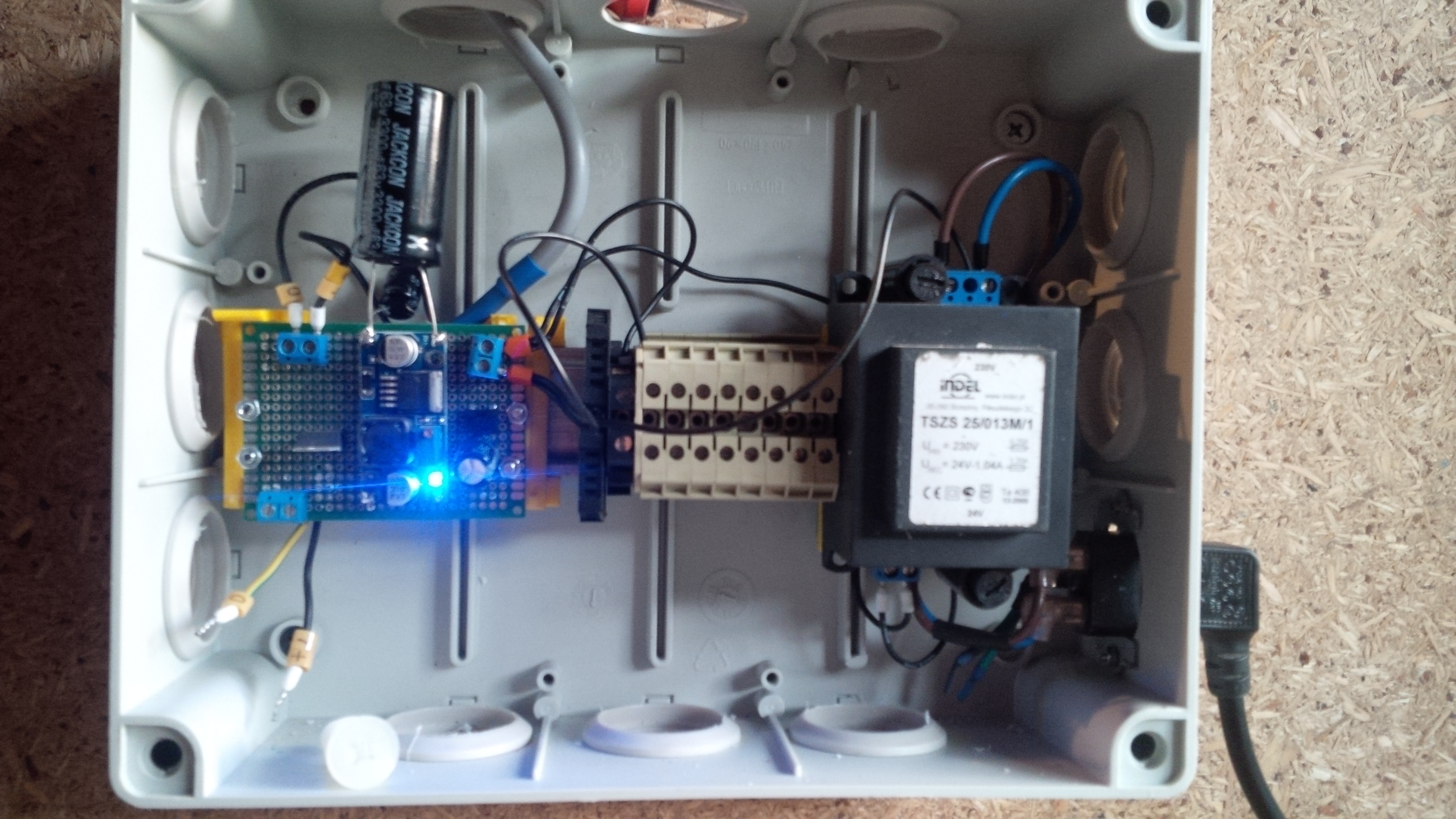
and control box with 2 ProMinis:
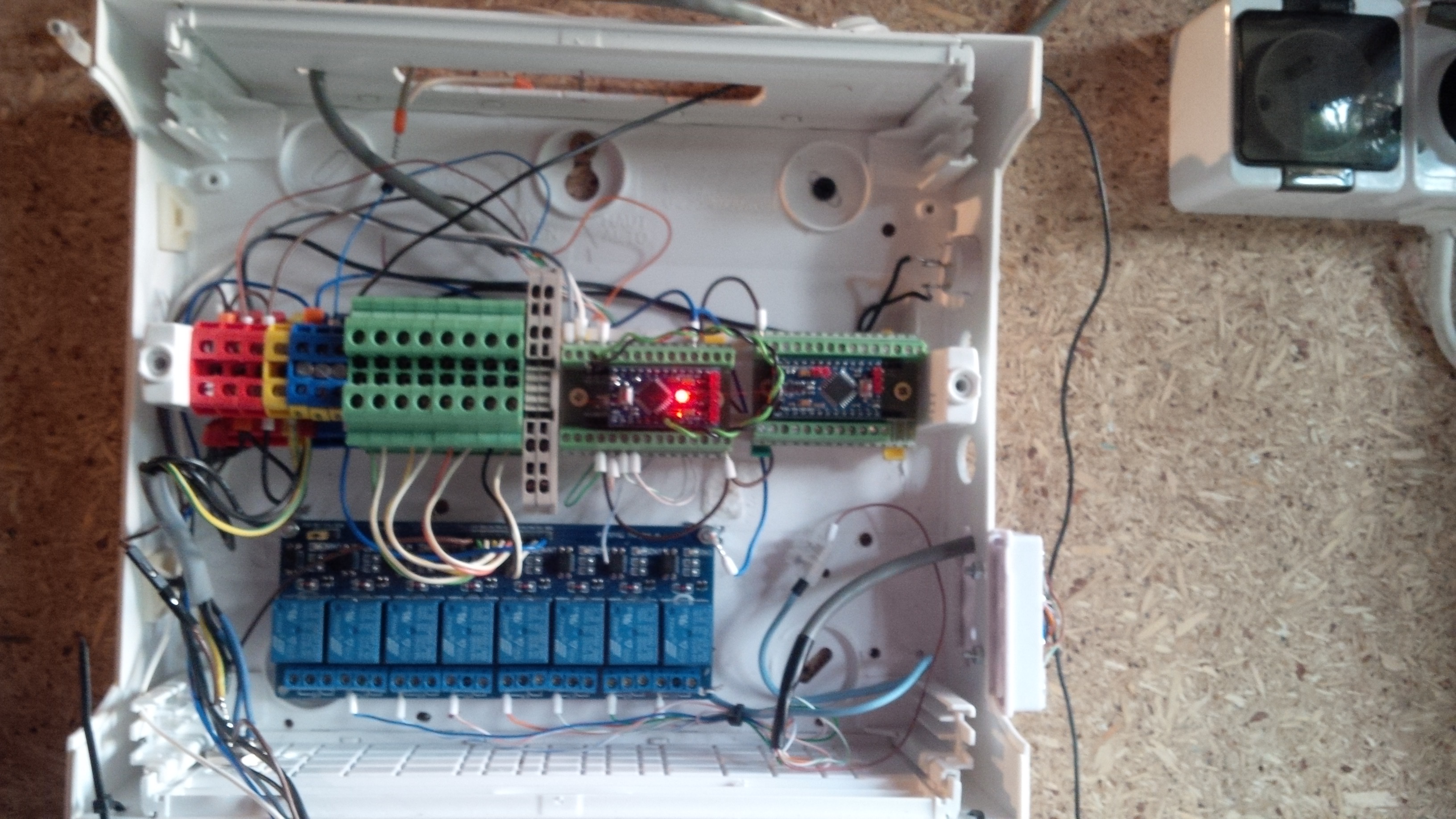
-
@karl261
Thanks,
in case I2C yes, and no.
with 1st generation [with 1 ProMini] I used I2C port expander PCF8574.
with 2nd generation [with MEGA2560] just pins, 8 pins, declared like this:/**** Kepad settings /
const byte ROWS = 4;
const byte COLS = 4;
char keys[ROWS][COLS] = {
{'1', '2', '3', 'A'},
{'4', '5', '6', 'B'},
{'7', '8', '9', 'C'},
{'', '0', '#', 'D'}
};byte rowPins[ROWS] = {47, 45, 43, 41};
byte colPins[COLS] = {39, 37, 35, 33};
int i2caddress = 0x20;
Keypad_I2C kpd = Keypad_I2C( makeKeymap(keys), rowPins, colPins, ROWS, COLS, i2caddress );with 3rd generation - plan to have 2nd ProMini with PCF expander.
attached library I use.
0_1474294070076_Keypad_I2C.zip
and some pictures of generation 3, which is under construct :)
Power supply:

and control box with 2 ProMinis:

@marekd Thanks for the detailed reply. What the monster capacitor for in gen 3?
I plan to build my keypad with one pro mini and the PCF8574. Like your gen 1 & 3. How did / are you planning to wire the PCF8574? It seems rather straight forward according to this:
https://www.hackster.io/venkatesh_rao/i2c-keypad-73a012
Is this the wiring you are using? Or is it different?
Since I am building a battery keypad, I was also planning to use the interrupt line of the PCF8574.
-
@marekd Thanks for the detailed reply. What the monster capacitor for in gen 3?
I plan to build my keypad with one pro mini and the PCF8574. Like your gen 1 & 3. How did / are you planning to wire the PCF8574? It seems rather straight forward according to this:
https://www.hackster.io/venkatesh_rao/i2c-keypad-73a012
Is this the wiring you are using? Or is it different?
Since I am building a battery keypad, I was also planning to use the interrupt line of the PCF8574.
